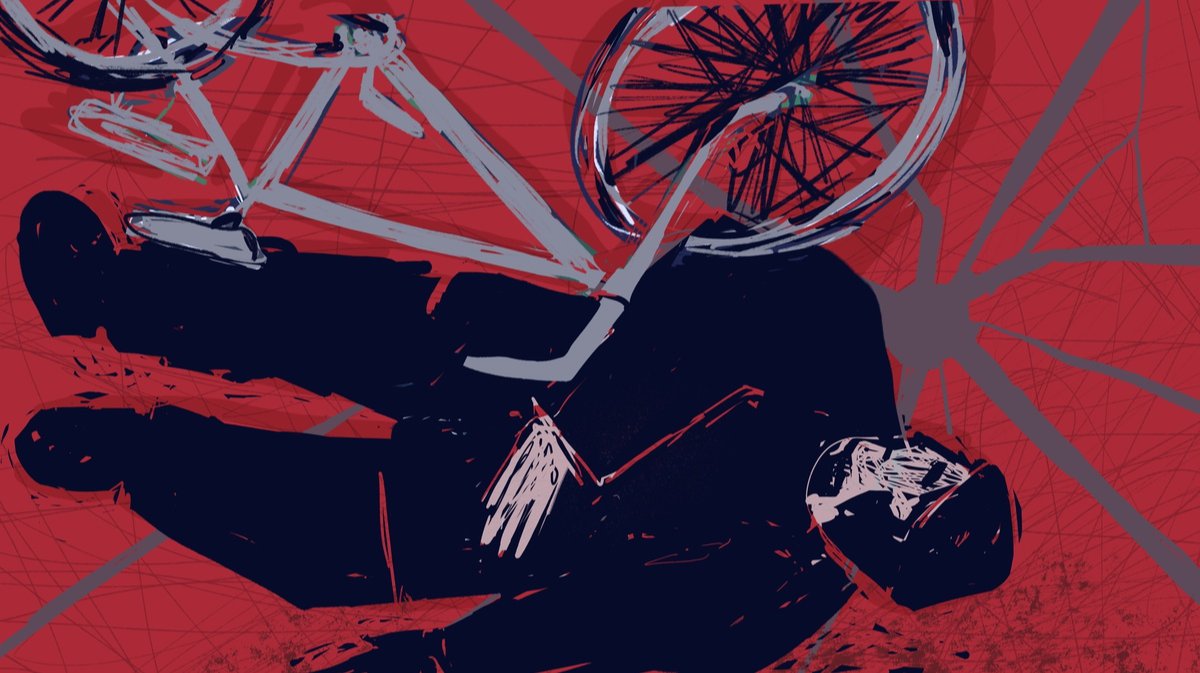Shootings on Yablunska Street
His posthumous photo in the New York Times became known all around the world.
A cyclist wearing orange threaded gloves, the kind used by construction workers, lies on his back on the roadway of Yablunska street. Next to him we see a fence with brick pillars, a sign with “Townhouses” written on it (property in Bucha has always been in demand), a shell crater filled with water, and burnt fragments of something. In the distance, we see several male figures leaving the scene, also with bicycles — the main local transport during the occupation... Many cyclists were killed in those days.
The author of the photo is Mykhailo Palinchak, a documentary photographer as well as personal photographer of the fifth president of Ukraine, Petro Poroshenko. Palinchak arrived in Bucha immediately after the Russians retreated and special units of the National Police of Ukraine purged the town of saboteurs and enemy collaborators.
Bodies, shot and burnt, were everywhere; the process of bringing them to the morgue was only just beginning. Some, who had been executed by a shot to the back of the head, had a white rag tied behind their backs: a piece of sheet or something similar. Civilians dared not step out of the house without this sign on their sleeve. At the time of execution, the cloth served as a pair of handcuffs.
“They were lying there for days, probably weeks. I’ve never seen anything like it in my life and hopefully never will again”, Palinchak later told Ukrainian online news outlet LB.ua. “...I took photos for about a week and then I couldn’t do it anymore, so I stopped. This, by the way, is also one of the differences between Ukrainian journalists and Western ones. Western journalists come here on an assignment, work for two or three months, and then leave. They work in shifts and have an opportunity to leave, rest, freshen up, and come back energised. Whereas we live here and have to see it and record it every day without respite.”
The NYT investigative journalists had spent a lot of time in Bucha. They monitored social networks and searched for reports of family, friends, and colleagues missing in the city from late February to late March 2022. They verified footage from Ukrainian military drones and co-operated with forensic experts. An example of the scale of the crimes committed: reporters attempted to identify those who perished in Yablunska street — men, women, and children — 36 people in total. When their interactive article was published on 21 December 2022, four more victims remained unidentified.
The cyclist in orange gloves was identified fairly quickly: in April, after a DNA test, the remains of 57-year-old Mykhailo Romaniuk were taken from the morgue in the town of Bila Tserkva (the morgue in Bucha became overcrowded almost immediately) and buried at the rapidly expanding cemetery.
The elder brother
An old wooden fence surrounds the plot of land, known in Ukrainian as obijstya, on which stand two buildings: the parental house, inhabited by Hanna Hryhorievna Romaniuk, and another house belonging to her daughter, Kateryna. A grey cat is strolling through the yard, purring and asking to be petted, as if feeling the proximity of spring.
In the living room of Hanna Hryhorievna’s house, the paint on the floorboards has long since worn out. There is a patchwork quilt on the sofa, cellophane-covered boxes on the polished wardrobe, and a makeshift altar on the chest of drawers: icons intermingled with diplomas, topped by a portrait of a young man — as if from a yearbook.
“Is that Mykhailo?” I ask.
She cries silently:
“No, that’s Seryozha, the youngest, fifty years old. He was taken to the war. I pray for his well-being.”
Leaning on a stick, she leads me to a tiny bedroom, smelling of candle wax and also filled with portraits from the past:
“My husband and Mishko [short for Mikhail], the eldest, are dead… Lord, forgive me for saying such things, but how could you allow it? Children should bury their parents, not the other way round!”
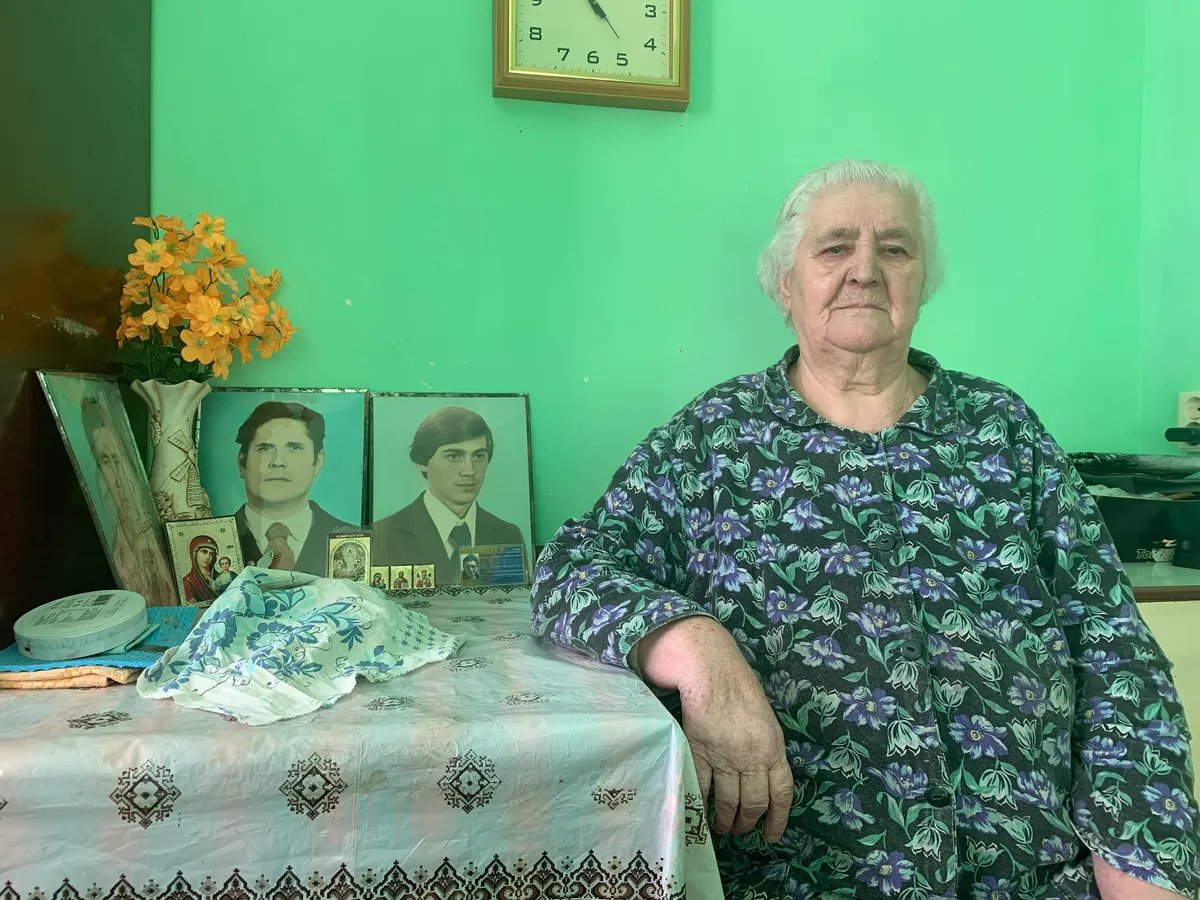
Hanna Hrihoryevna Romaniuk in her house, by the portraits of her late husband and recently killed elder son Mykhailo. Photo: Olga Musafirova, exclusively for Novaya Gazeta Europe
As the big war arrived in Bucha, it brought with it not only shelling, but also the sudden disappearance of electricity, water, gas, internet, TV and, worst of all, the cell phone network. People had to seek it out, sneaking around, risking death. Everyone tried to shelter in their homes: those who had cellars or basements hid underground. To lose contact within a large family was the worst thing in the world.
“I was sitting here, everything humming, the walls shaking. As if it was coming straight at me,” Hanna nods towards the blue-painted window.
Tanks marked with the letter “Z” barely fit into the narrow forest street.
Mykhailo was not afraid to ride around Bucha. He returned with news, each piece more horrifying than the other.
An important feature of the occupied town was that the Russian military units were also constantly moving around. One day they were absent from a neighbourhood, and the next day they would appear in it. They burst into houses and conducted clearance operations, searching for civic activists and veterans who fought in Donbas in 2014-2015. Occasionally, they would shoot people simply because they did not like their facial expression.
The killings of civilians were not done for any reason. These punitive expeditions were effectively a game of Russian roulette. Mykhailo told his mother and sister several times that he would go to the enlistment office. “Who cares about my age? I’m tired of hiding!” He did not seem to think about the fact that the local enlistment office had stopped working two weeks into the occupation.
On 4 March, Kateryna agreed with the arguments of her grown-up son: they should try to flee to Poland together with her daughter-in-law and granddaughter, even though everyone had heard that refugees were being shot right in their cars. Russian roulette… Hanna flatly refused to join them: “You want to have a burden on your hands? Save the child! I’m eighty-six, it’s about time to die”.
In the end, Kateryna managed to flee from Bucha. It was a relative of hers, Oleksandr, who informed her of Mykhailo’s death — only several days after it happened.
“On 6 March, he and Mishko were cycling towards the house of Oleksandr’s parents. Neighbours informed them that a shell had hit the house and the father was trapped under the rubble, so they had to save him. They passed along Vokzalna Street, crossing the railway tracks as usual. Then they turned onto Yablunska Street. There was a sniper… Because there was military equipment further down there and nobody was supposed to see it. The bullet hit Mishko in the head and he died on the spot, whereas Sashko [short for Oleksandr] had his backpack punctured. Taking the body was out of the question. There were dead people lying all over the place…” Kateryna recounts.
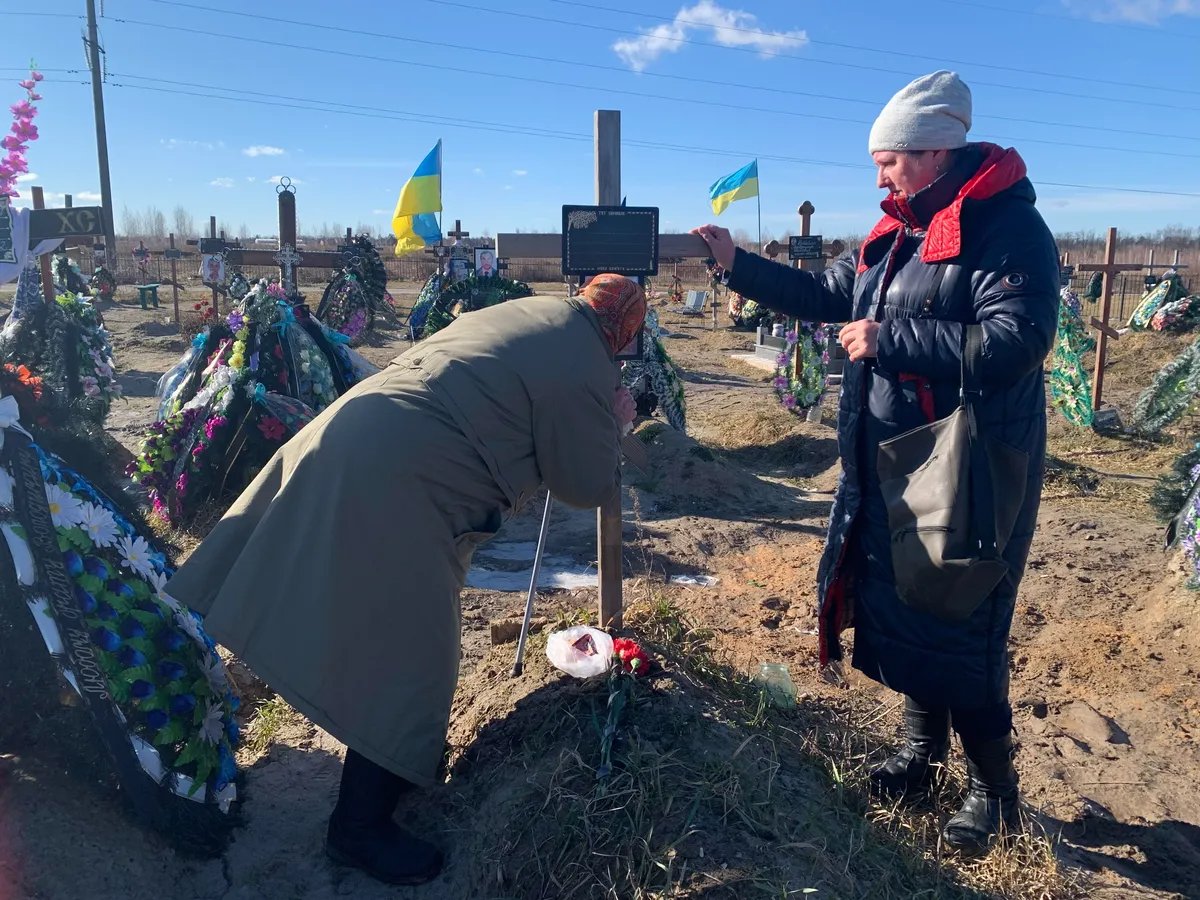
Hanna Hrihoryevna Romaniuk and her daughter Kateryna near Mykhailo’s grave. Photo: Olga Musafirova, exclusively for Novaya Gazeta Europe
“But nobody told me,” Hanna cries quietly.
“And rightly so. Otherwise, you would have refused to evacuate with Seryozhka’s family. And he ordered that you be taken to Western Ukraine even if you had to be dragged along,” Kateryna justifies the decision to Hanna, seemingly not for the first time. They had managed to reach the north-western city of Lutsk.
Hanna Hryhorievna found out about her oldest son’s death only after Bucha was liberated — while still in Lutsk, she needed to give a DNA sample for identification purposes. She was also not present at Mishko’s burial. His body was brought out in a black bag: “Remember him as he was, we advise you not to look inside. He had been lying on Yablunska Street for a month”.
Kateryna and Hanna Hryhorievna speak of the smell of death that still hovered over Bucha when they returned home. At least 465 civilians died during the occupation, 419 of whom were killed by the Russian military. Among the dead were 12 children and very young people. Over fifty people were found unburied. As yet more graves are being discovered, the local authorities continue updating the statistics.
Afterwards, we went to the cemetery to see Mishko. The day was sunny and windy. Rows of fresh graves stretched all the way up to the forest.
On the way back, Hanna Hryhorievna recalled how in Soviet times, she often went to Moscow to sell homegrown strawberries.
“I do not want to know anything in their language now, I will not say a word in Russian,” she says, “But I used to speak it! It could be their grandsons that committed the killings…”
We said farewell at the massive oak tree next to the Romaniuks’ obijstya. Nearby stood the white blocks of an unfinished mansion, with forest undergrowth beginning to sprout from the mounds of rubble. A grey cat came out from the gate. It purred and rubbed itself against our feet.
“Over there,” Hanna Hryhorievna pointed with her stick, “they burnt a family. They brought them closer to the forest on purpose, because they did not just kill the woman, but tortured her first, and she screamed and argued with them. They cut her behind, broke her leg and her arm. The woman stopped screaming as she bled to death. My neighbours were not afraid to come out: ‘Don’t burn them, please! Let us bury them!’ They were threatened with a machine gun — not much you can do… Burnt remains were left behind. Stray dogs came running, picking at them. And this one ate as well,” she points to the cat, “the neighbours saw it…”
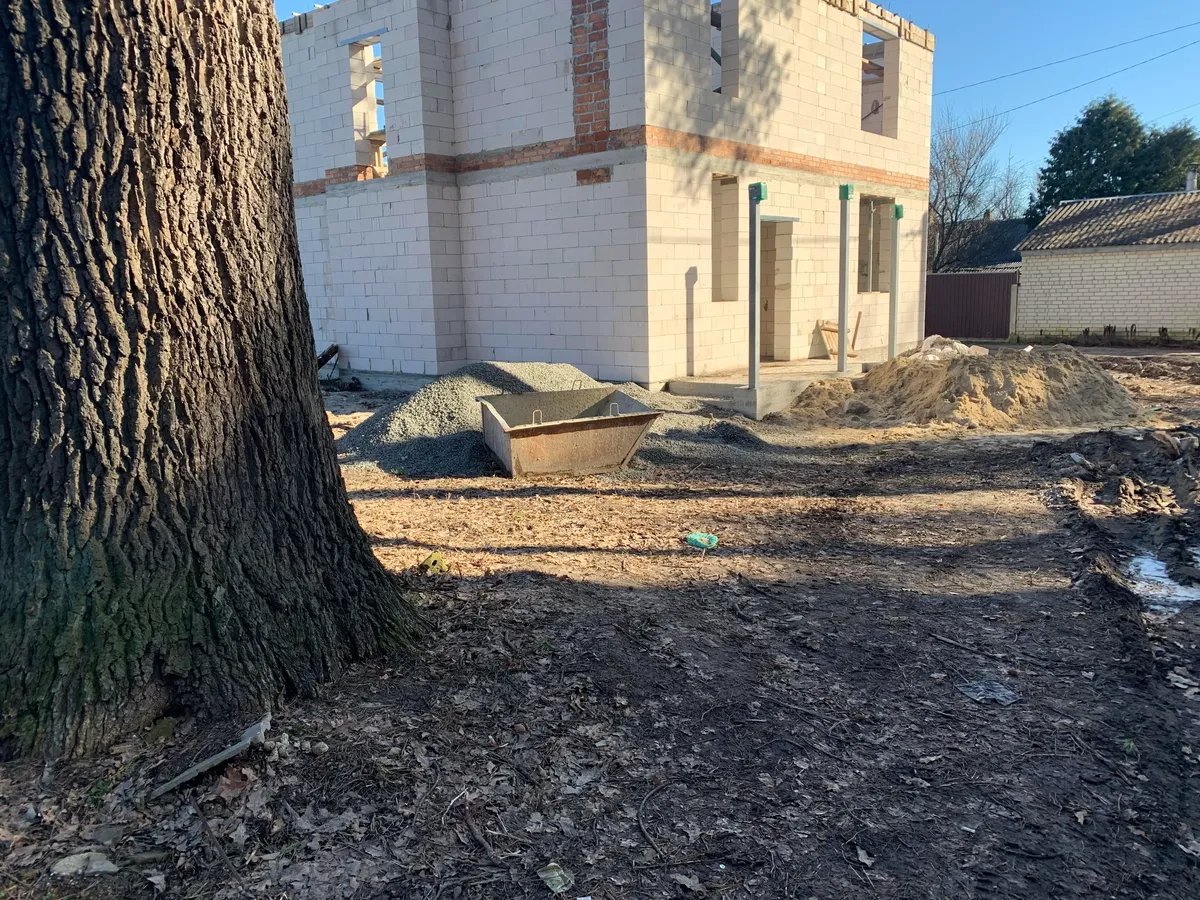
The place near an old oak tree where Russian troops tortured and burnt a family. Photo: Olga Musafirova, exclusively for Novaya Gazeta Europe
Hundreds of DNA samples at a time
In early May, thirty forensic experts from the French Gendarmerie arrived in town, assisting their Ukrainian colleagues with the identification process. This came as a reaction of the International Criminal Court and other relevant international bodies to President Zelensky’s appeal to urgently dispatch teams of investigators to Bucha to collect and record evidence of Russian war crimes.
Even before the arrival of Western experts, the pro-Kremlin media began screaming: “A massive provocation! A stitch-up! They smeared a bunch of actors with blood and scattered some dummies!” Later, the tune changed: “It was the Ukrainian army that carried out the massacre after the voluntary withdrawal of Russian troops from Bucha! Their aim was to besmirch those who are participating in the special operation!”
The Gendarmerie team brought with them mobile labs and portable DNA sequencers and set up a tent camp near the morgue. The French experts, people of hardened minds, admitted that they had been ready for anything. Yet reality surpassed all expectations.
Now, in February 2023, a refrigerator van belonging to the Ukrainian Ministry of Defence was parked in the backyard of the district morgue. A gurney was pulled up to it. Staff in blue scrubs, caps, and masks began unloading the bodies. These were citizens of Bucha being brought back from the front lines. Serhiy Lyakhovich, local forensic medical expert, had only a few minutes for me.
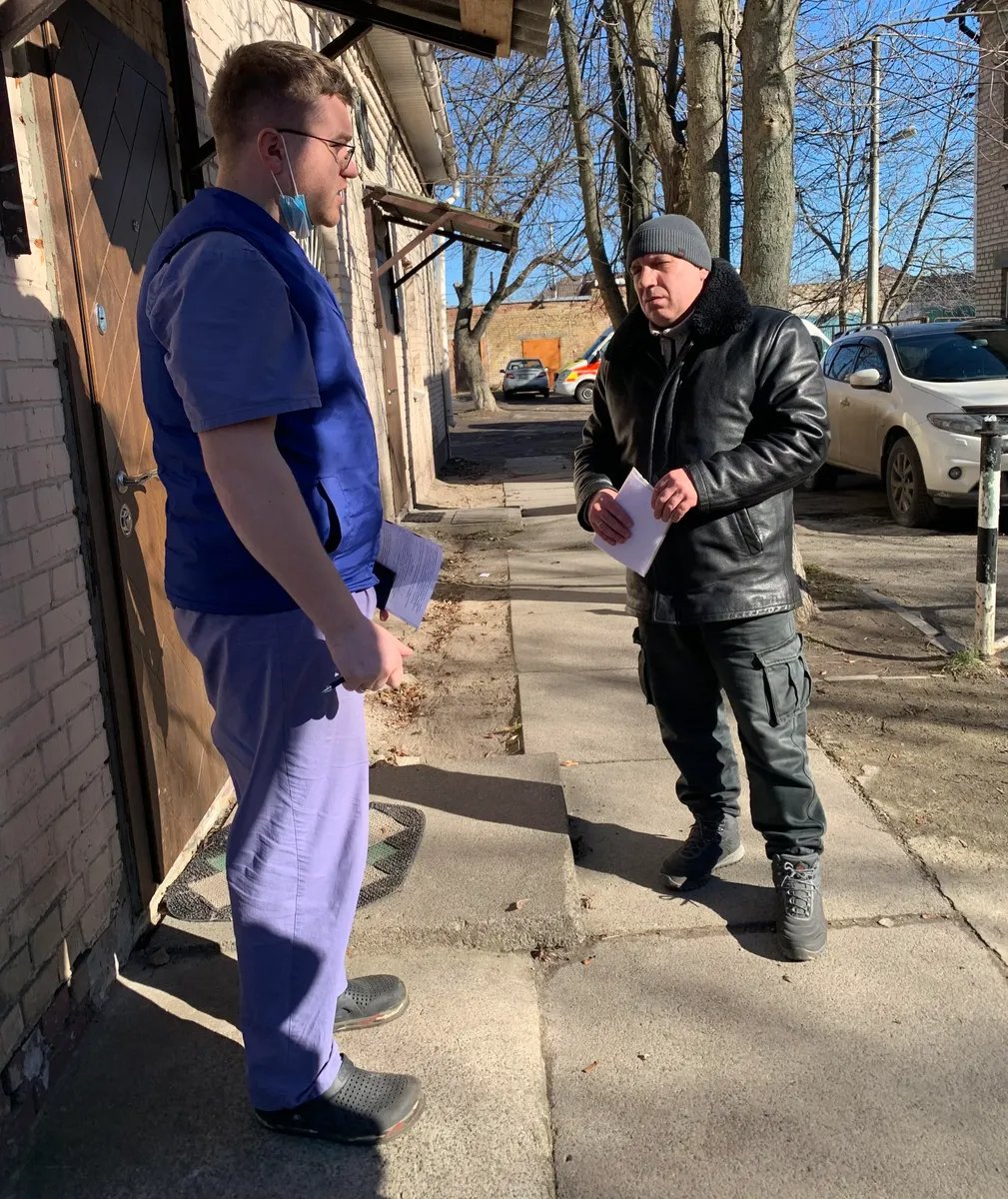
Serhiy Lyakhovich explains to a brother of a missing person what he should do. Photo: Olga Musafirova, exclusively for Novaya Gazeta Europe
Lyakhovich assessed cooperation with the French team as follows:
“The examinations were carried out in parallel: myself or a colleague and a gendarmerie expert. A group of Ukrainian police forensic experts also worked with us. They took samples, and the French team had specialists who did the same thing. Double control. Unfortunately, our level of forensics leaves much to be desired. The French are much more advanced.”
“Was the help tangible?”
“Yes. We had hundreds of DNA samples at a time. One team worked in the autopsy room, while another one was in the tent camp taking samples from people whose relatives had gone missing or were likely killed in the Bucha area.”
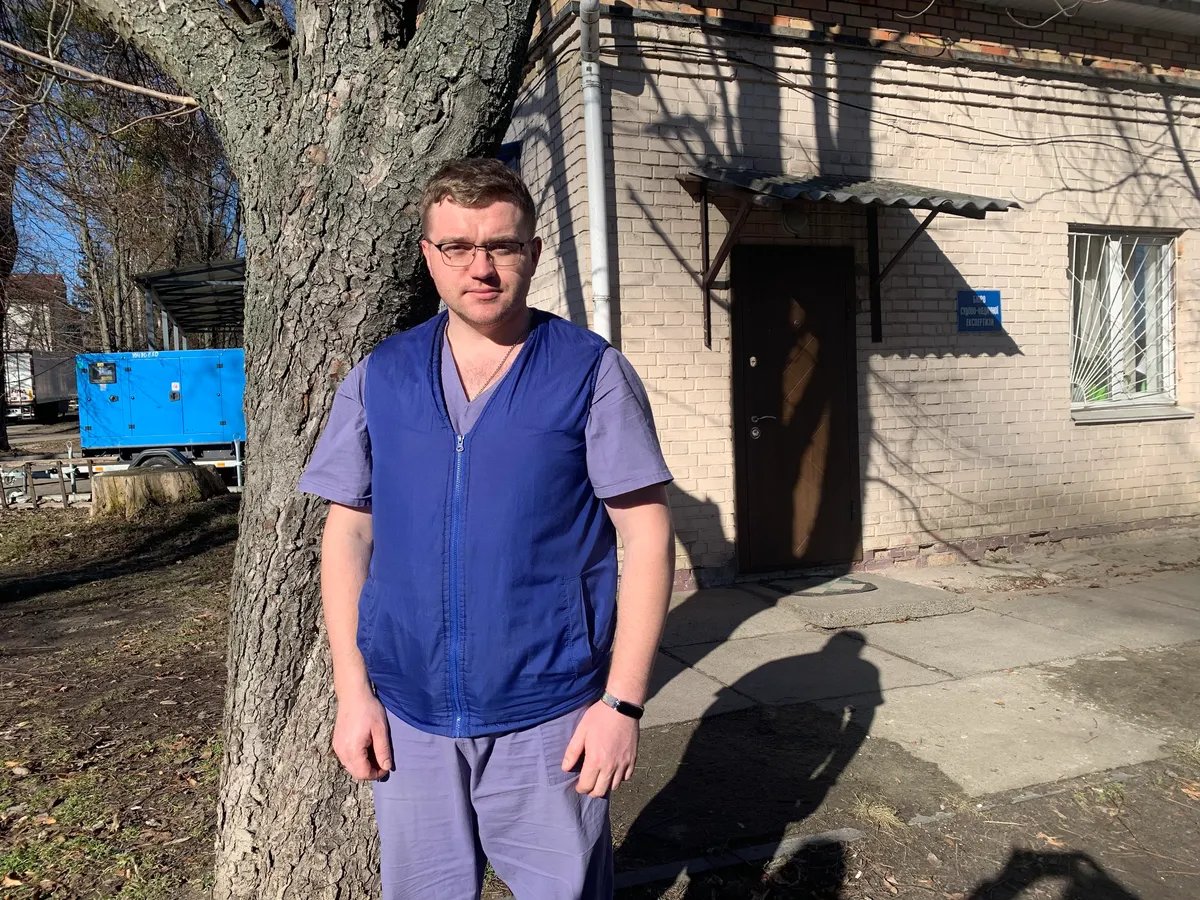
Serhiy Lyakhovich, a forensic expert, recalls: “The French experts were shocked by the atrocities and the mass executions.” Photo: Olga Musafirova, exclusively for Novaya Gazeta Europe
“Did the French team hand over the report on their work to the Ukrainian side?”
“I don’t know. The documents are probably in the General Prosecutor’s Office.”
“And did they share their impressions unofficially?”
“They were shocked by the atrocities, the mass executions, and inhuman behaviour even towards the dead. There were bodies crushed by armed personnel carriers after death. The French were also amazed by our experts. It is no secret that they imagined Ukraine to be a third-world country where the level of intelligence leaves much to be desired. So, when they saw how we, using primitive tools, manage to do the same things that they do with their super-technology… My point is, our levels of training are approximately the same. However, if the French team were put in Ukrainian conditions, they would not be able to work as they did.”
When asked whether any exhumed remains of Russian soldiers who died in the Bucha area have been examined, Serhiy answers in the negative. He did not, however, completely rule out the possibility: there had been body parts brought to the morgue from Hostomel Airport that were so charred that there was no point in searching for the remainder of uniforms or documents. When there are signs that the remains belong to the enemy, they are handed over to the Ukrainian military for the purposes of exchange.
“And how were the burnt bodies handled?”
“According to protocol. We take DNA samples and store them accordingly.”
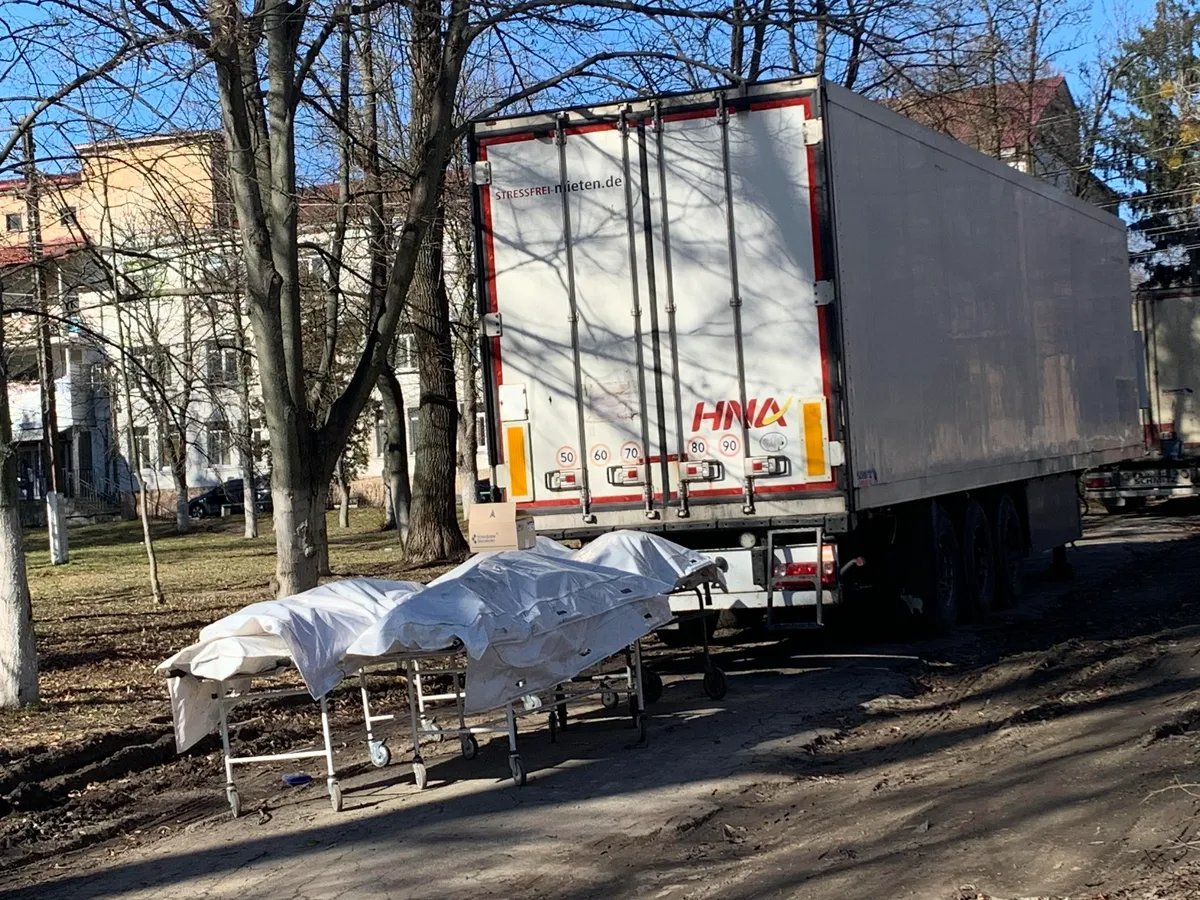
A refrigerator with bodies of dead soldiers near the Bucha forensic bureau. Photo: Olga Musafirova, exclusively for Novaya Gazeta Europe
We are alive
The English word “butcher” has captured everything that happened here in March 2022 with such precision that it does not seem at all delusional to think that the masterminds behind the “special operation” might have chosen the town in advance in order to intimidate Ukraine and the West.
Almost a year after the Bucha massacre, the Kyiv suburb looks alive again. It is filled with cars, and finding a parking place takes a while. Couples are cooing in cafes. Even the Church of St. Andrew, where the mass graves were located, is white again — not a single trace of shrapnel on its walls. During the exhumation, bodies were lifted from the pits using the church door, which had been taken off its hinges and tied across with ropes…
There remain, however, buildings where the windows are still boarded up. Other houses have suffered greater damage, and the street is permeated with gaping holes, like a mouth that has had several teeth pulled out by a dentist.
According to statistics from the town council, over a thousand pieces of property have been damaged. 138 of them were destroyed completely, while the rest were severely or partially damaged. These include 44 social infrastructure facilities — hospitals, schools, kindergartens, etc. And that is without taking into account the damage done to critical infrastructure.
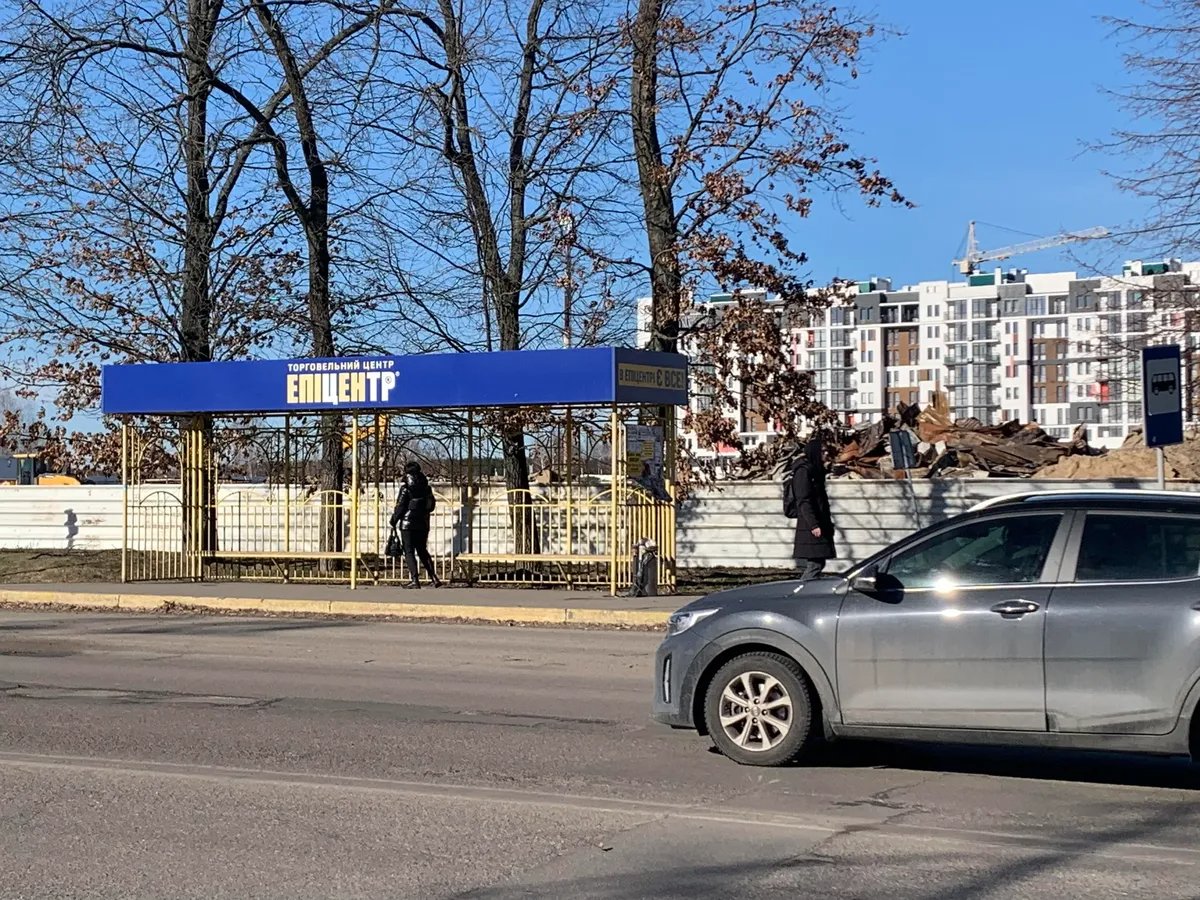
The ruins of the bombed shopping centre Epicentre have been cleared out, with only the bus stop left as a reminder. Photo: Olga Musafirova, exclusively for Novaya Gazeta Europe
The “Continent” housing complex, a modern 600-flat development near the railway station, stands out in this story. At first, it was fired at from a tank. Then, the Russian military turned the building’s lobby into their base: such a level of comfort! It was from here that they went to the positions from where they shelled the town of Irpin; it was here that they returned, got drunk, broke down apartment doors, and looted the property.
Those residents who did not manage to escape were turned into a “human shield” and locked in the basement for three weeks. Thankfully, they had the time to stock up on food and water before the shelling became too fierce. They were allowed to take out the buckets, which served as toilets, only once every three days.
Meanwhile, the “liberators of Europe from the Nazis” loaded the real toilets, along with fridges, washing machines, TV sets, orthopaedic mattresses, computers, and clothing onto their military vehicles before retreating.
Karina Samokhvalova, a former media manager, has volunteered with a group of like-minded people to document the war crimes committed in Bucha. She says they are planning to open a museum dedicated to the occupation of Bucha in the local art gallery.
Her laptop, which Karina never parts with, contains an active database of the town’s dead and missing people as well as the coordinates of their relatives. 70 remains are still unidentified.
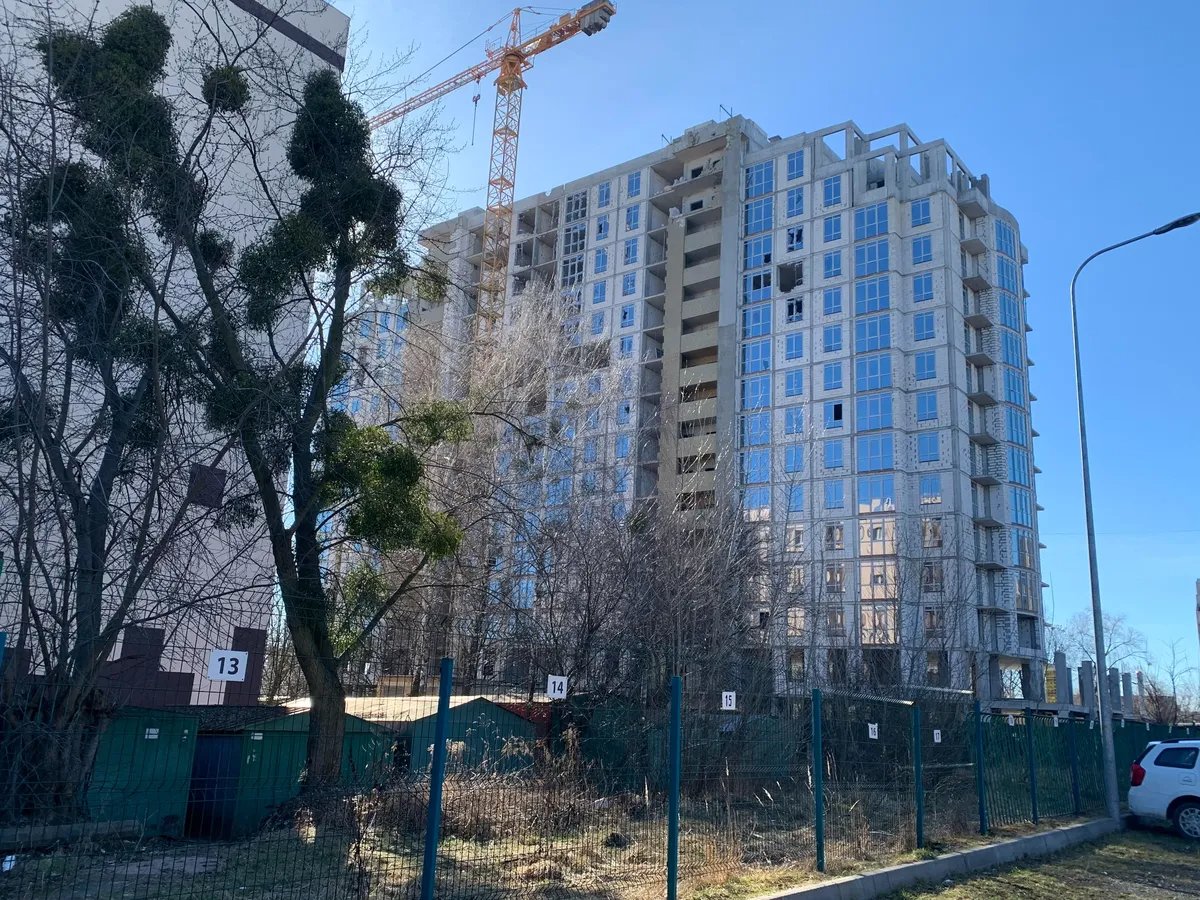
People could have been living here. Photo: Olga Musafirova, exclusively for Novaya Gazeta Europe
I notice a mural next to the town council that does not resemble the giant murals that one grows accustomed to in the capital. It shows a little girl reaching towards a “no entry” sign with “WAR” written in black over the white dash. With a spray can, she writes “STOP” over the sign.
Italian street artist Salvatore Benintende, who signs his works as TVBoy, is the author of several anti-war graffiti in Bucha. His signature in blue and yellow is barely legible at the foot of the mural. Benintende visited the liberated cities of the Kyiv region following British artist Banksy. Both of their visits were not widely publicised. TVBoy is also known for a mural outside Barcelona’s city hall where he depicted Vladimir Putin in an orange prison jumpsuit, handcuffed and behind bars.
‘Investments will come. But after the war’
A journalist is considered lucky if they manage to catch Mykhailina Skoryk-Shkarivska, deputy mayor and “Bucha’s minister of foreign affairs” (and that is hardly a joke), for an interview. I, for instance, managed to find her far from her office at a meeting with a focus group of internally displaced people within the Bucha area.
Formerly a media manager and civic activist, “Minister” Mykhailina has met and led dozens of delegations around Bucha after the occupation. Presidents, prime ministers, high-ranking representatives of the UN, NATO, the Council of Europe, and the European Commission were all shocked by what they saw. It is impossible to count all the conferences and video calls with potential foreign investors that Skoryk-Shkarivskaya has attended. From a plethora of designs, negotiations, and projects there emerged a sort of “Marshall Plan” for Bucha: “Investments will come. But after the war is over. For now, we are patching up the holes using domestic resources”.
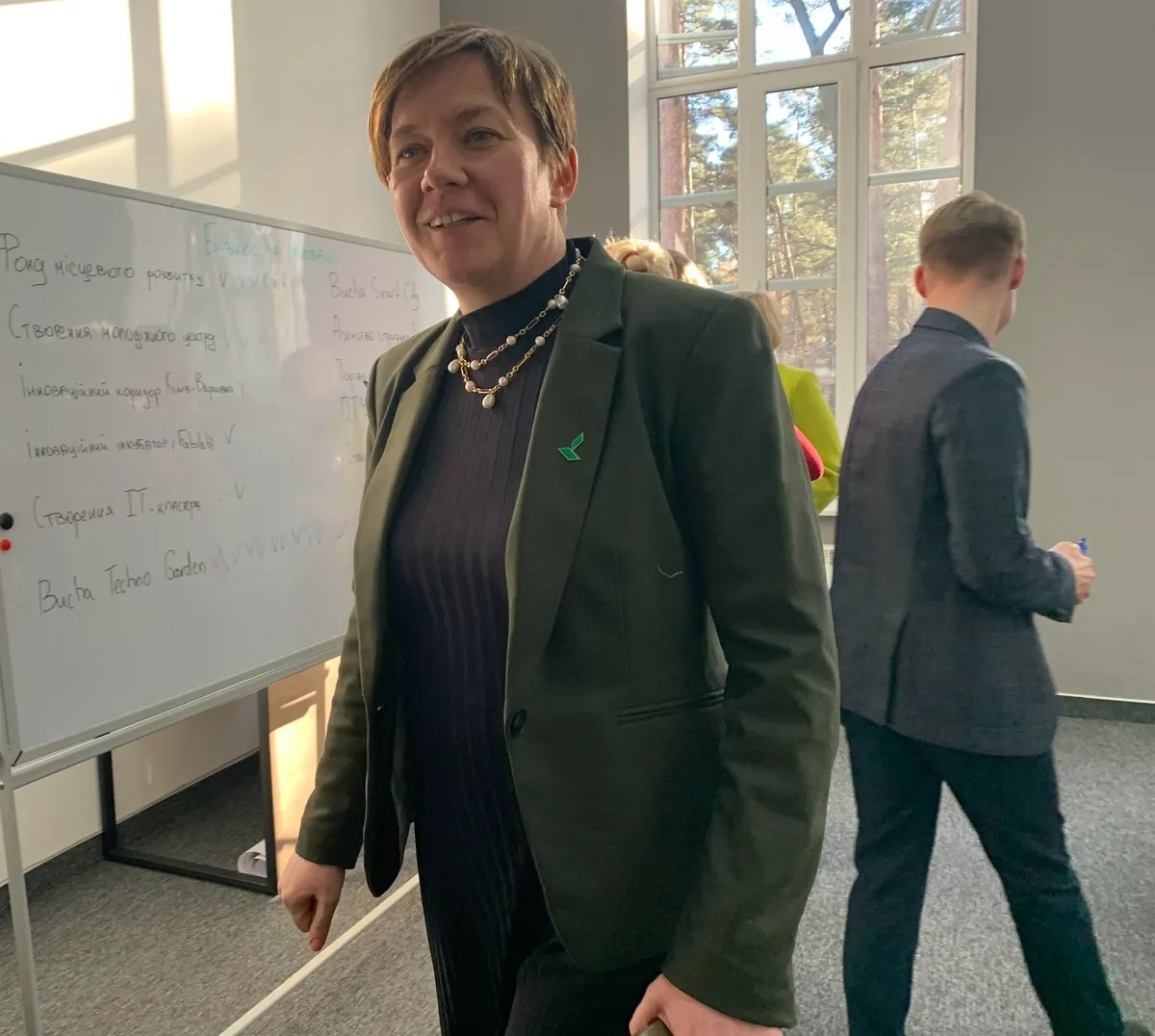
Mykhailina Skoryk-Shkarivska, deputy mayor and Bucha’s “minister of foreign affairs”. “The Ukrainian society will need to learn to live and fight at the same time.” Photo: Olga Musafirova, exclusively for Novaya Gazeta Europe
Big foreign capital expressed compassion towards the hero-city (a status that Zelensky conferred on the town on 25 March 2022), but prioritised its own risks: if one invests millions in reconstruction and development today, Russian missiles might smash everything up again…
The deputy mayor firmly believes that Ukrainian society will have to learn to live and fight at the same time.
Even once a certain restoration of the state border with Russia has been reached, the “neighbour” will continue raging for a while. The country has not yet found its own formula for how to combine those two things correctly.
I ask whether Mykhailina has an explanation as to why the occupying forces were particularly brutal in Bucha?
“Putin had a plan: to airdrop troops at Antonov, the largest cargo airport in Hostomel. The Antonov runway is located in the Bucha region. So already on 25 February, houses in Bucha were on fire, and on 27 February, a column of Russian tanks attempted to break through Bucha to Kyiv. The Ukrainian Armed Forces managed to divide the column into three parts and break it up between Bucha and Irpin, on Vokzalna Street and at the ring near the “Continent” housing complex. This was precisely where the idea of seizing Kyiv in three days failed. Then, Putin regrouped his forces. Additional equipment was brought in from the side of Borodianka and Hostomel, they began digging trenches in the villages, and on 3 March they entered the Bucha area from different directions.
She points out that people had the illusion that it would be safer in the villages and that the enemy would not touch civilians.
“But the offensive stopped, and the Russians became stuck in Bucha. Next came both the order and the strategy: to take revenge on civilians for the military failure. We know that the invaders were given instructions: we see the same ‘handwriting’ in different neighbourhoods.”
Skoryk-Shkarivska gives examples:
“Two elderly sisters were living together. One of them was shot, the other, who was care-dependent, died at home shortly afterwards. Should her death be considered natural, unrelated to the crimes of the Russian military? A mother of three children hid in a basement for a month and died on 23 March — of heart failure, the forensic report said. But it is obvious why her heart failed.”
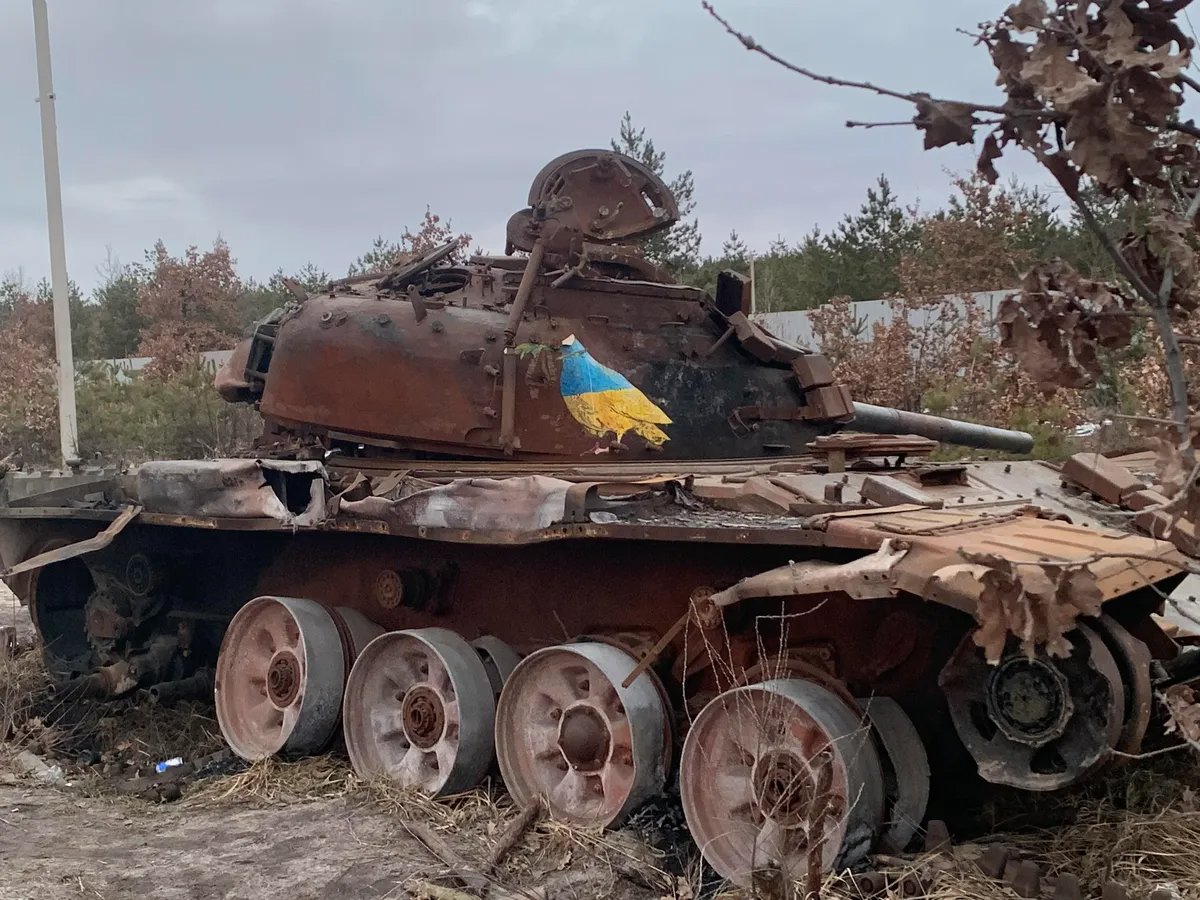
Destroyed, already rusty tanks on the road leading to Bucha. Photo: Olga Musafirova, exclusively for Novaya Gazeta Europe
“Ukraine does not have a “martyr-city” status. Perhaps it would be more in line with the realities of Bucha?”
“Bucha is none other than a hero-city! Of its 53,000 inhabitants, 3,700 remained after the de-occupation, and the Red Cross immediately compiled a register. About 50,000 people had fled through semi-official “green corridors” at great risk, whereas the survivors of terror were the first to start rebuilding the city. In a very short time, they cleaned up and rebuilt as much of the infrastructure as was possible. By the end of May, we had electricity, gas, and running water. On June 1, Children’s Day, we held our first celebration, which was far more massive than we had thought possible. Resilience, resistance, a willingness to be reborn — these words describe Bucha. Strategically, now more than ever, we have to show the history of Ukrainian success. And yes, Bucha remembers everything, follows the investigations, and awaits the punishment of the perpetrators. There are more than enough witnesses.”
‘Put your own mask on first’
As soon as I arrived at Gymnasium#5 for a meeting with psychologist Viktoria Nechiporenko, who works with children who have seen death, an air-raid siren sounded. Classes were interrupted: everyone had to go to the bomb shelter. The students poured out into the street routinely, looking quite content.
Vika, on the other hand, was upset. She had wanted to show off her office, demonstrate therapy techniques using sand, plasticine, drawing, finger painting, and her observation diaries. Instead, she had to talk to me about whether it is possible to “rebuild” Bucha in a psychological sense as we sat on a bench under a tree.
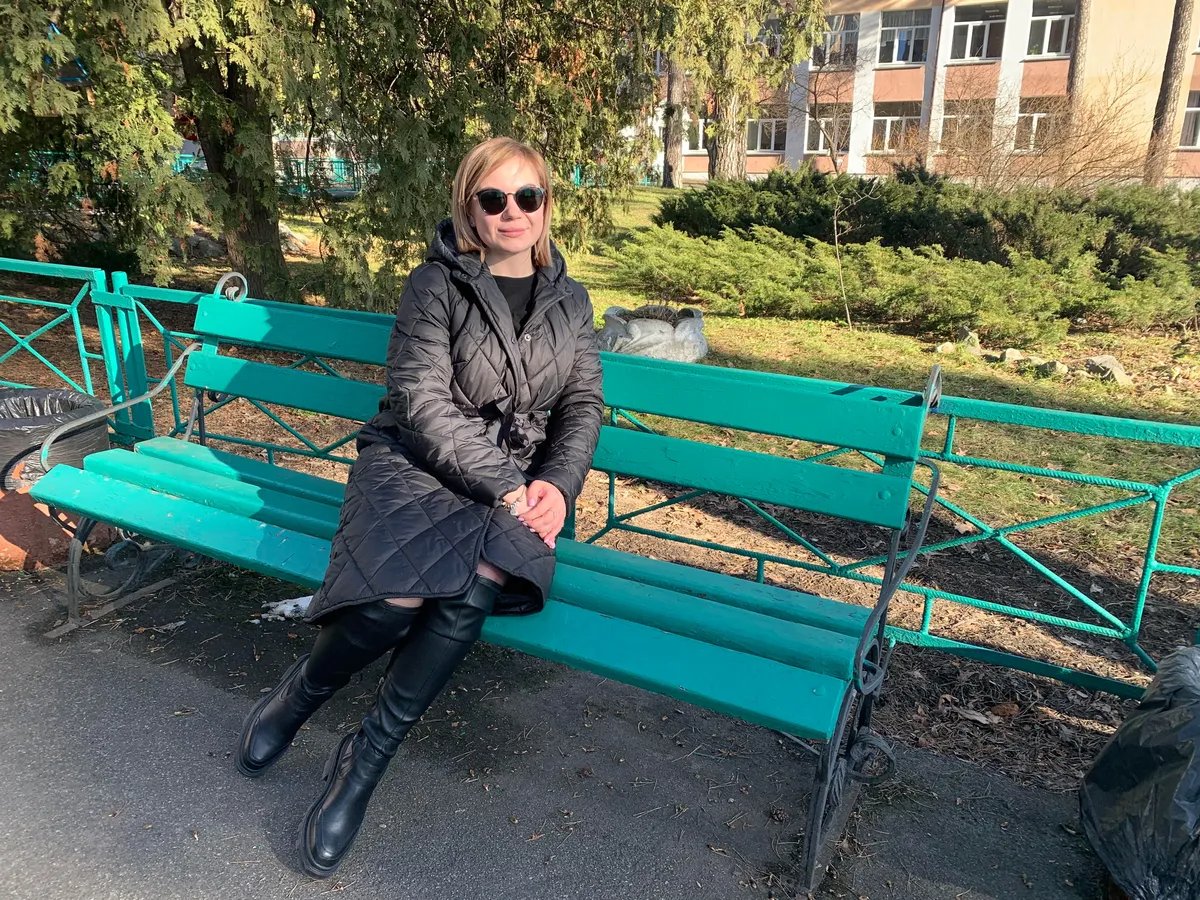
Psychologist Viktoria Nechiporenko: “Only 10-12 percent of the Ukrainian population will have to deal with PTSD, no more.” Photo: Olga Musafirova, exclusively for Novaya Gazeta Europe
“Let me assuage you,” Nechiporenko sensed something with her professional gaze. “Only 10-12 percent of the Ukrainian population will have to deal with PTSD, no more. Let me explain why. Our psyche also has an immune system. There are many terrible things with which it can cope on its own. You have to distinguish between a traumatic or stressful situation and PTSD. Now, about the children. Of course, the approaches are individual, but children in general endure hardships more easily because they still do not possess a fully formed worldview. Their psyche is more plastic, they can change emotions more swiftly. Adults during the occupation were constantly stressed because of dark thoughts and premonitions, and this made an already harsh reality even harder to bear. Children do not have that. Imagine, for instance, a situation where the child becomes frightened or upset…”
“A mother is shot before her son’s eyes. Is the child frightened or upset?”
“I know of such cases. Still, it is only a traumatic situation. It can be dealt with through professional help.”
One of the first calls was about a nine-year-old boy whose hair had partly turned grey due to stress. The family had fled from Hostomel, a military town near the airport, under Russian missile fire. The child was brought to the counselling centre in Bucha, where Viktoria worked, by his parents. They complained of sleep disorders, nightmares and anxiety. As soon as the boy began to sleep well, the family stopped attending therapy. They decided that it was enough.

School students on the way to the bomb shelter after an air raid warning. Photo: Olga Musafirova, exclusively for Novaya Gazeta Europe
“Children are entirely dependent on the significant adults around them,” Nechiporenko continued. “If adults try to monitor their psychological state and cope with their own anxiety, their children will immediately feel better. Oftentimes you see that the child is fine, but it is the mother who has problems. It’s like in an airplane: put your oxygen mask on first.”
She pointed out the increase in the number of patients with nocturnal enuresis — five-year-olds, seven-year-olds, thirteen-year-olds…
She referred some of them to a neurologist and some to a psychiatrist, because apart from bedwetting, there were also some physiological disorders present: twitches and nervous tics. Older children, who were already able to put their emotions in words, reacted well to awareness techniques: the worst is over, we are safe here and now.
“Relatively safe, at least,” Viktoria concluded.
The air-raid siren kept on going.
‘We have a lot to do on this earth’
During the occupation, the land belonging to the St. Andrew’s cathedral of the Orthodox Church of Ukraine (OCU) became the burial grounds for murdered civilians. It was not that the Russian soldiers felt pangs of Christian conscience at leaving the bodies to be mauled by packs of hungry dogs. It was themselves that they worried about. It was getting warmer, after all, so there was a risk of epidemics.
On 10 March, they had to allow trenches to be dug next to the church. People preferred burying dead relatives in shallow graves in their yards and vegetable gardens. There was no way to get to the cemetery: outside of town, every inch of land was exposed to gunfire. The dead were taken to the church on trolleys looted from a half-destroyed convenience store nearby.
Archpriest Andriy (Galavin) sent his wife and children to his parents a few days before the invasion and returned to his parish in order to be useful to it. It was a conscious decision — he felt that war was in the air.
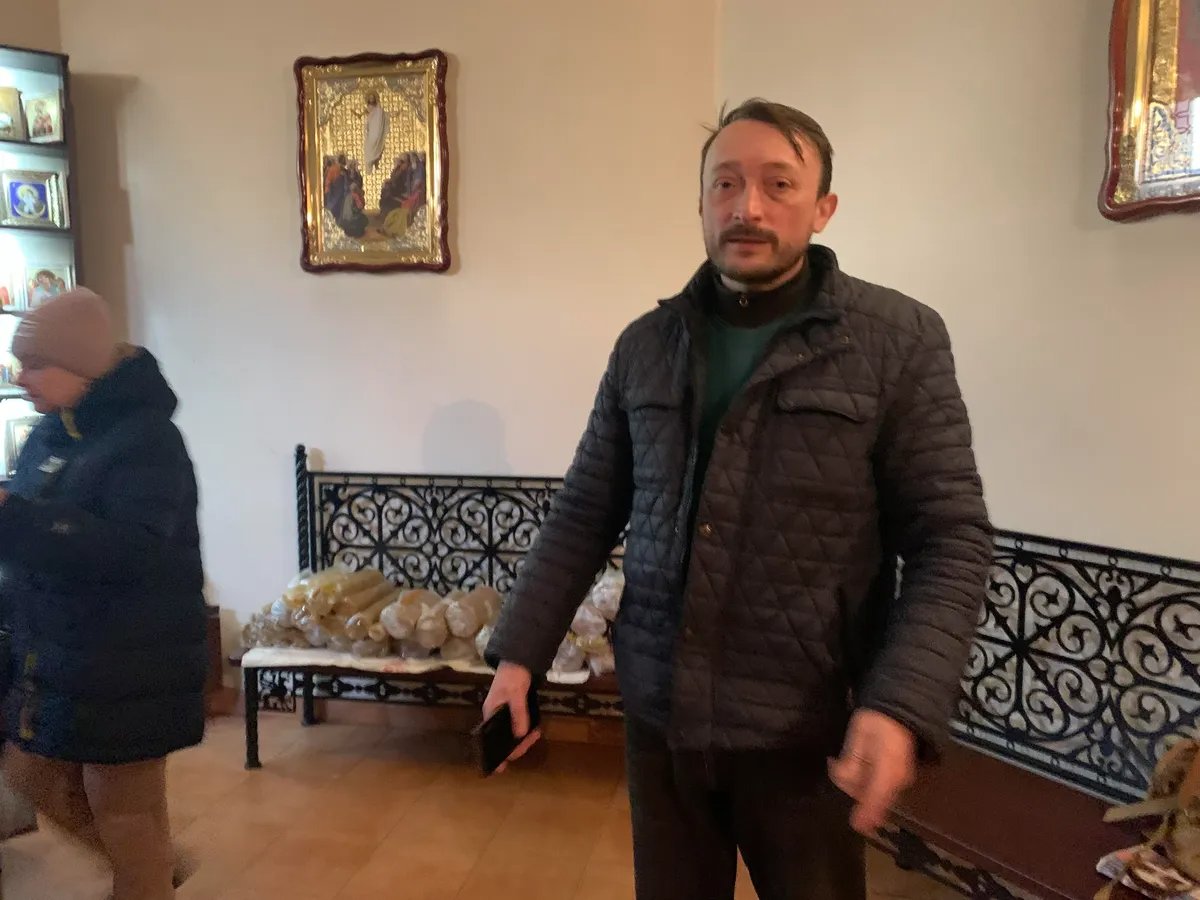
Archpriest Andriy Galavin: “Remember tragedy, but don’t dwell on it after victory.” Photo: Olga Musafirova, exclusively for Novaya Gazeta Europe
The tank column that entered Bucha on 26 February started shelling the town at dawn. The cathedral was also hit. Thankfully, nobody inside was injured since service had not yet started at the time of the shelling. The faithful held their last gathering before the occupation here on 26 February, “Ancestral Remembrance Saturday”.
Priest Andriy Galavin carried his cross. He testified before God, the law, and the people about the crimes against humanity. After the occupation, he did not refuse meetings with international prosecutors, Western politicians, or journalists.
We talked in a room in the church basement, which I at first mistook for a bomb shelter. It turned out that there was an exhibition of documentary photographs upstairs — how the world saw Bucha after Bucha. Another exhibit was a sketch of the future memorial to be erected on the site of the mass graves.
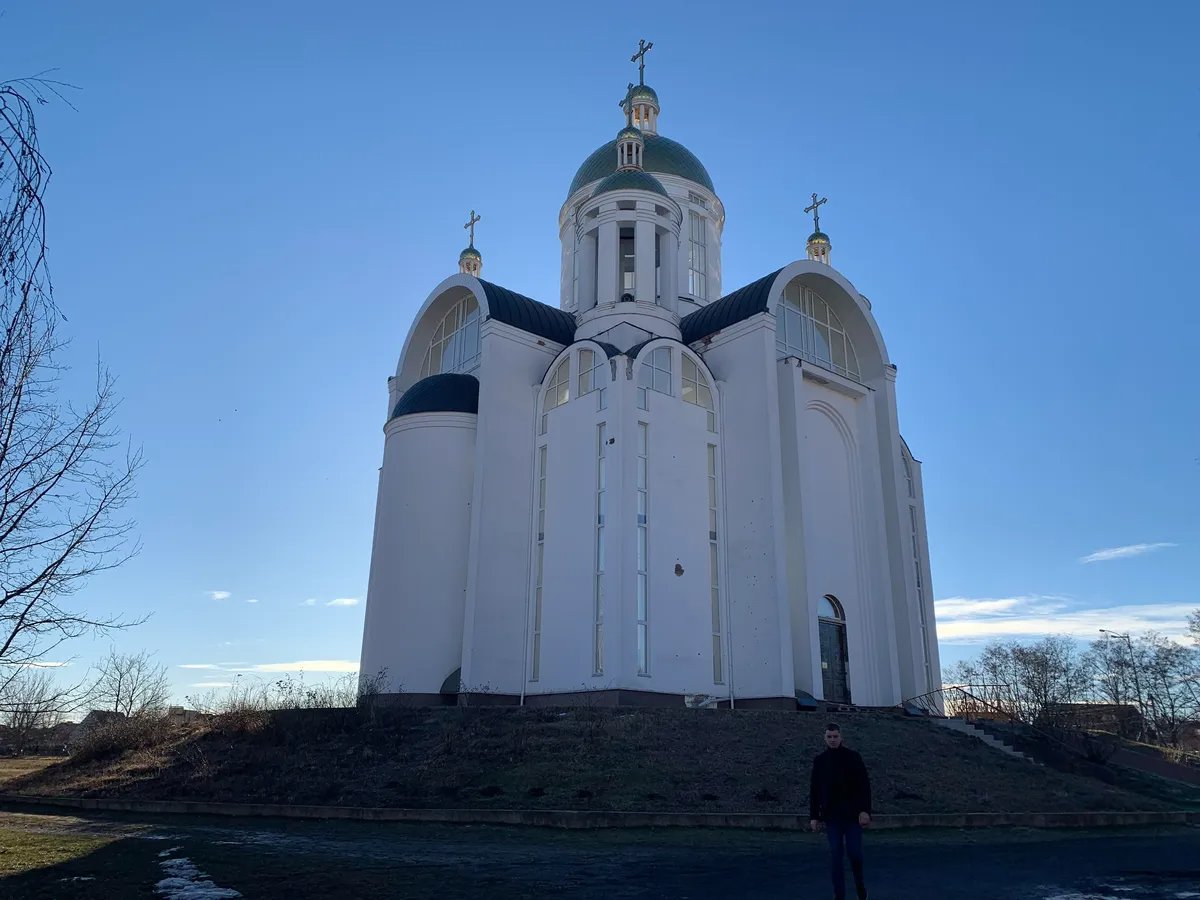
No signs of shelling left on the façade of the St. Andrew cathedral following repair works. Photo: Olga Musafirova, exclusively for Novaya Gazeta Europe
“Father, can one live in this town and be happy a year after mass executions?”
“It is not only Bucha that is traumatised in Ukraine, unfortunately. Mariupol, Bakhmut, other places… Ukrainian soldiers are dying, someone’s children who left their peaceful jobs and went there to defend us, to stop Russia. The way the Russians are fighting, not sparing their army, not counting losses, covering our land with their dead bodies, is similar to how it was in the Second World War. Hundreds of thousands were killed then only in the liberation of Kyiv, for example… But we must be happy now — and not even to spite the invaders. I do not really care what they think. (Noticing my reaction.) You perceive happiness to be in external manifestations…”
“Perhaps.”
“Yet I am talking about inner happiness. Until 24 February, we were all scurrying around like a hamster in a wheel. Working out everyday life, solving mundane problems, and yet if you were to ask us if we were happy, you’d be surprised. During the occupation, when there are tribulations, explosions, no light, intentional isolation from information, prayer turns to a conversation with God, and happiness is found in a slightly different dimension. God is always there, but we are not always there. Every circumstance should be used as a chance to rise to a new inner level.
Remember tragedy, but don’t dwell on it after victory. We must look forward in order to become a healthy nation without hatred. It doesn’t matter whether the Russians will repent afterwards or not.
We should take care of ourselves, of our spiritual health, in order to live for love. We have a lot to do on this earth.”
Father Andriy could well have been among those killed or tortured simply for belonging to the Orthodox Church of Ukraine, although he did not walk around town in a cassock and with a cross on his chest. Smiling, he adds that in such a case he would have to “hold the Ukrainian flag to complete the picture”. He then goes on:
“Two priests died here: one from the Church of Ukraine, he lived in Bucha and officiated in Kyiv, and another one of the Moscow Patriarchate, of pro-Russian views, from Irpin. The Russian mine didn’t care…”
“Did the Russians break into the church?”
“They did. They broke the upper windows and climbed in”
“Did they loot it?”
“There’s nothing to take. It’s an open space, lots of light. I suspect they set up a sniper’s nest.”
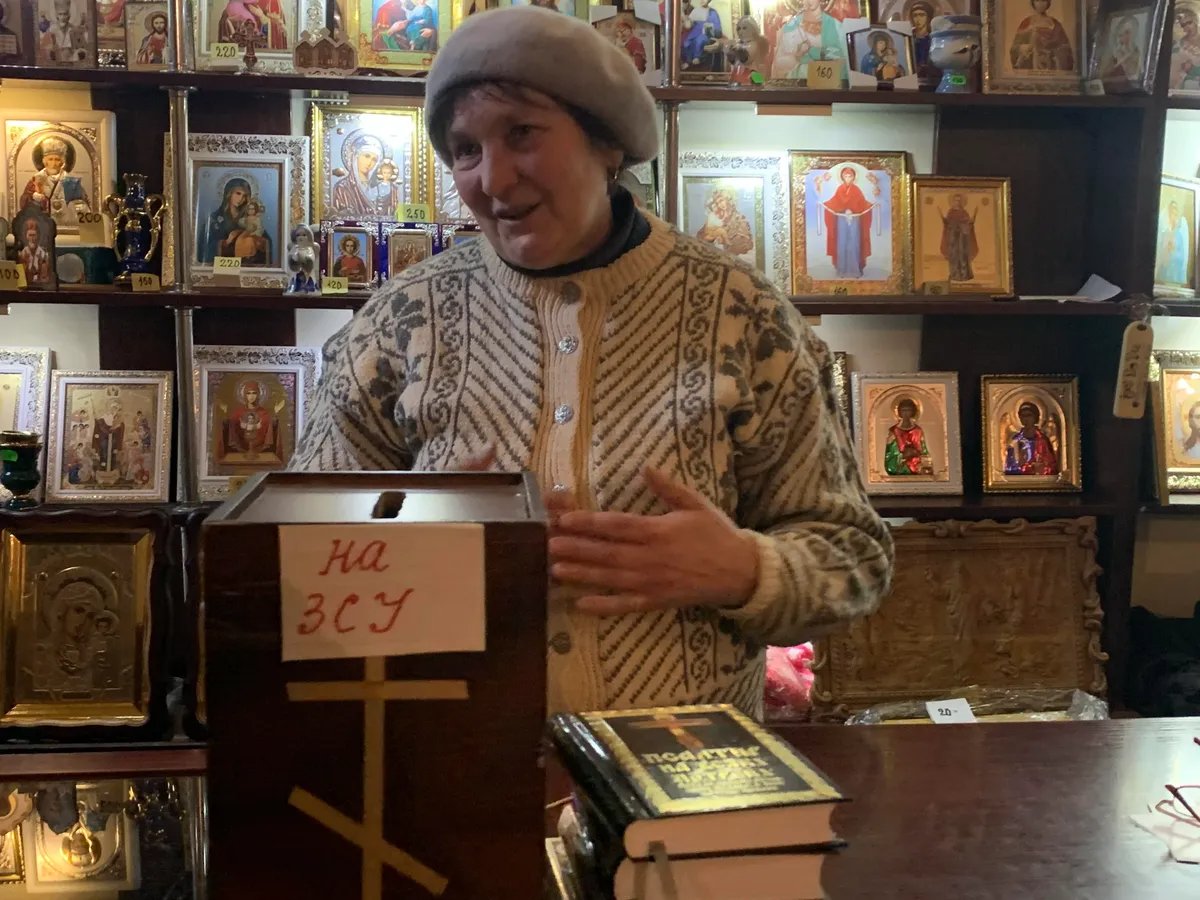
Tetyana, a woman selling candles at the cathedral, also spent a month under occupation. Photo: Olga Musafirova, exclusively for Novaya Gazeta Europe
I wondered if there were people in Bucha who had collaborated with the occupying army, pointing the finger: over here lives a “Banderite” priest, over there a family of Protestants, whereas those are Maidan supporters… When war first broke out nine years ago, the Donetsk region, alas, abounded with such stories.
“The Russians were informed in advance,” Father Andriy says. “But they also carried out impromptu executions. Without a list.”
He recalls one of the improvised shallow graves in the park: that of a woman burnt inside her car. People covered the body with soil and put the car’s number plate on the mound instead of the usual cross to make it easier to identify. After a pause, he continues:
“A singer from our church was also executed. He was tortured, then the whole family was burned.”
The priest lists the victims and the circumstances of their deaths in a calm tone. He is bearing witness. In confirmation of his words, he shows me pictures on his smartphone that make you want to squeeze your eyes shut. His gallery is filled with such images.
I did not dare ask if he would ever delete them.
Bucha — Kyiv
Join us in rebuilding Novaya Gazeta Europe
The Russian government has banned independent media. We were forced to leave our country in order to keep doing our job, telling our readers about what is going on Russia, Ukraine and Europe.
We will continue fighting against warfare and dictatorship. We believe that freedom of speech is the most efficient antidote against tyranny. Support us financially to help us fight for peace and freedom.
By clicking the Support button, you agree to the processing of your personal data.
To cancel a regular donation, please write to [email protected]
